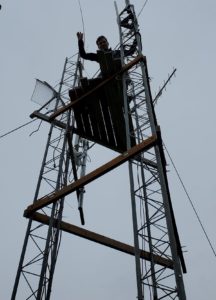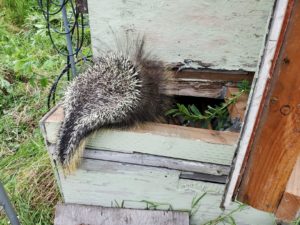AARC Installs LoRa Gateway At Hillside South Site
Thanks to Matt Ostrander’s (KL4QH) dogged determination, a LoRa gateway has been installed at our Hillside South site. On Sunday, June 28, Matt and Kent Petty (KL5T) spent a good part of the day at the site. Matt did the climbing while Kent did the ground crew work and running (you can’t do a

job like this without forgetting something, and indeed, we did and Kent had to make a tool run).
Site work included installing 2 new runs of Cat5 cable, installing the 6.5 ft tall 900 MHz vertical antenna, and installation of the weatherproof box housing the LoRa gateway. We fabricated brackets to mount the box on-site and successfully got the system online.
Also accomplished during the visit was a repair to some Cat6 cable feeding one of our 5 GHz sectors that had been attacked by a raven. Pesky critters! And speaking of critters, we had a couple close encounters with a pesky porcupine who has taken up residence in the space under the site shed. Glad Matt spotted this guy from his view atop the tower platform…he was right outside the shed entrance!
You may ask, what is LoRa? LoRa (Long Range) is a spread spectrum modulation technique derived from chirp spread spectrum (CSS) technology. OK, OK………I know…what the heck does that mean. Well, that’s what I pulled off the SEMTECH website as the first sentence of the descriptor for what LoRa is. Now, I’m going to turn this over to Matt for a description in human terms…..Matt…please proceed…
Essentially, LoRa is a low-bandwidth, low-cost, high-reliability protocol for the Internet of Things (IoT). By networking sensors using LoRa, you can establish bi-directional communication without service fees (such as with cellular networks) and experience very long battery life (upwards of 5 years on some sensors). With usable receive thresholds up to -20dB below the noise floor, LoRa delivers exceptional range despite the crowded 900MHz spectrum. In order to accommodate as many potential uses as possible, the KL7AA gateway operates on The Things Network (TTN), a community-oriented network open to anyone. LoRa packets travel from node to gateway and then are forwarded to a LoRa Network Server–in this case TTN. From there, packets are passed along based on whether a given node has a matching registered application. In short: you can activate a LoRa node on TTN, register an application, and pass data along to anywhere, such as debugging websites, IoT platforms like AWS, or to your own custom web-based API endpoint. In practical terms, setting up a cabin-monitoring motion sensor or a trailer-theft-prevention GPS-enabled tracker has become significantly more accessible if you live within range of a LoRa gateway.


